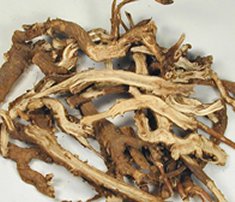Chai Hu

  | Chai Hu in TCM:Explore the properties of Chai Hu according to Chinese
Nutrition and Traditional Chinese Medicine (TCM):
Factoids:
English Name: bupleurum, hare's ear, Chinese thorowax root, red thorowax root, "kindling of the barbarians"
Pharmacuetical Name: Radix Bupleuri
Properties: bitter, acrid, cool
Temperature: cool
Channels: LV, GB, PC, SJ
Flavors: bitter, pungent
Special Properties:
circulates qi, clears heat, disperses wind
Alternate Forms:
- Sheng: better for shao yang syndrome or fever (12g)
- Cu Zhi: better for LV Qi Yu (6-9g)
- Mi Zhi: better for SP qi sinking (3-6g)
Actions / Indications:
- Harmonizes shao yang syndrome; reduces fever (alternating
chills and fever; flank pain, bitter taste, irritability, vomit, stifling
sensation in chest; fever from exterior syndromes; wind-heat headaches;
particularly effective for half-interior half-exterior disorders)
- Spreads LV qi; relieves constraint (LV qi stagnation
with chest and flank pain, menstrual disorders, emotional instability;
disharmony between LV and SP)
- Lifts SP Yang (prolapse of organs or diarrhea
due to sinking of SP qi; head, eye, ear disorders due to yang qi that
fails to ascend)
Special Notes:
- Pharmacologically Chai Hu has been shown to have analgesic and antipyretic
functions, sedative effects, anti-inflammatory actions, hepatoprotective
functions, cholagogic functions (increases bile production), antihyperlipidemic
properties (reduce triglycerides and cholesterol), immunostimulant benefits,
and antibiotic actions.
- A comparison of Ge Gen, Chai Hu, and Sheng
Ma reveals that Ge Gen is weakest to lift SP
yang while Sheng Ma is strongest to lift
SP yang.
- Used to treat shao yang headaches, along with Huang
Qin and Chuan Xiong.
Contraindications:
- (cc: Since Chai Hu is acrid and dispersing it consumes LV yin. Caution
with yin deficient heat, LYR, LV Wind, or rebellious qi)
- (cc: Chai Hu may have adverse interaction with interferon, inducing
LV failure)
Disclaimer: In accordance with our terms of service, by using this web site you agree that none of the information found on this web site constitutes medical advice. You should always consult your doctor before trying any particular food or herbal remedy to treat disease.
Folk remedies presented on this site are designed to address specifc TCM diagnoses, and are not one-size-fits-all. If you would like to learn more about Traditional Chinese Medicine (TCM) and how it relates to Chinese Nutrition, you can book in a free call with a licensed professional. There is no obligation to purchase.
[CLICK HERE for your free INITIAL CONSULTATION] |

